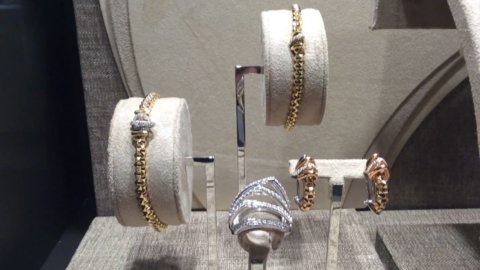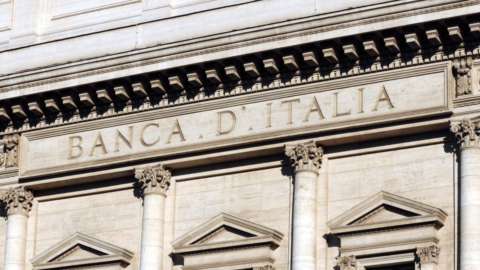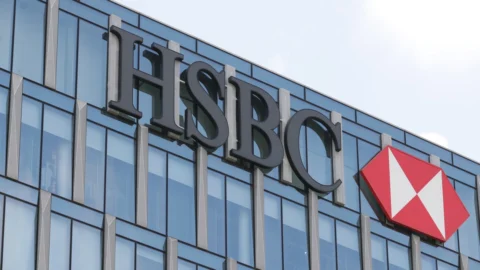Il goldsmith sector, often a crossroads of global trends and used as a litmus test of economic dynamics, showed good dynamics in Italy on international markets in the 1st quarter of 2022 with 1,8 billion exports, grew by more than 30% both in value and in quantity.
The comparison with 2019 shows the widening of the difference between the change in value (+37,8%) compared to the change in quantity (+9,1%).
Globally though the demand for gold jewelry marks a drop of 6,9% compared to 2021, after having achieved a full recovery of pre-crisis levels the previous year. This is what emerges from a quarterly study by the Studies and Research Department of Intesa Sanpaolo which shows how this sector - as well as that of precious metals more generally - is conditioned by many global factors, often in opposition to each other: from the recent restrictive monetary policies with a consequent rise in the dollar, to inflation, to Covid, but also to a changed mentality with respect to raw materials.
“The context is very uncertain and conditioned by various global factors for which the sector requires increasing attention towards the efficiency of production and distribution processes in order to preserve the high quality of the product without compromising the economic solidity of the sector” suggests the document.
Gold jewelry exports: the United States the largest buyers, followed by the United Arab Emirates, Switzerland and France
With over 250 million exports, glthe United States confirmed their role as the first outlet market for Italy, growing by 29,2% in the first quarter of 2022 in terms of value and 10,1% in quantity, with an overall effect of an increase in the average unit value of 17,3 .XNUMX%.
Exports are also doing well in terms of value United Arab Emirates which grows by 10,2% with substantial stability in quantity which determines an increase in the average value of 12,6%.
Flows towards are also growing sharply Switzerland (+ 33,1%) and France (+48,7%) which represent logistics hubs and reference markets for large companies luxury house, which is accompanied by an even stronger leap in quantity with a consequent consequent contraction of the average unit value compared to the 1st quarter of the previous year.
Less present are Chinese and Indian customers
The markets that discount the greatest delay are the Indian one (-26%) and the Chinese one (-8%) which represent more than half of the world figure; excluding these markets, world demand showed growth of 7%.
For Chinese market the months of January and February had seen a good trend in jewelery sales thanks to the stimulus of the celebrations of New Year and dealers' bias towards heavier gold products, but the sharp rise in the gold price in late February following the outbreak of the conflict between Russia and Ukraine and the further restrictions dictated by the approach”Zero-Covid” which has imposed lockdowns in cities such as Shanghai and Shenzhen, have had negative impacts on demand.
For Indian market, in addition to the increase in gold prices which led to a tendency to postpone jewelery purchases while waiting for more favorable prices, there was also the lack of weddings which had a negative impact on the trend in demand.
Gold and jewels: the districts of Arezzo, Vicenza and Valenza Po drive the market
There are three districts in Italy dedicated to the gold sector, Arezzo, Vicenza and Valenza Po: the first two in quarter1 showed growth in exports with rates above 30%, while they were more contained (+8,5%) for the Valencia district.
Ithe gold district of Vicenza recorded exports of approximately 490 million euros, up by over 135 million compared to the 1st quarter of 2021 (+38,4%) and by approximately 165 million euros compared to the January-March period of 2019 (+50,6, XNUMX%). The United States are confirmed as its first reference market with a value more than doubled in March 2022 compared to 2019; exports to Italy also double compared to the pre-crisis South Africa (+104,8%) and show positive trends with a full overcoming of the pre-crisis value also the United Arab Emirates which represent more than 10% of the district's exports. The markets that have not yet recovered the value of 2019 are Hong Kong (-39,7%) and Switzerland (-12,8%), even if in the 1st quarter of 2022 they still showed positive rates of change.
For gold district of Arezzo exports amounted to 731 million euro with a growth of 31,1%, higher than the average variation recorded in the previous year which stood at 23,5%. The United Arab Emirates are confirmed as the first reference market and despite the slight contraction recorded in the first three months (-2,0%) they still show a value higher than the 1st quarter of 2019 by +12,5%. Sales to the United States are accelerating which, thanks to growth of +26,6%, have more than doubled the pre-Covid value. We also note the strengthening of relations with South Africa (+49,5%) and with Algeria which in the 1st quarter made purchases from the Arezzo district in line with the annual figure for 2021, thanks to the legislative measures adopted from the North African market which at the end of 2021 simplified operations and settlement methods.
The gold district of Valencia Po achieved 370,6 million euros in exports, up by around 30 million compared to the previous year (+8,5%), but still down by around 88 million euros compared to the first quarter of 1 (-2019 %). The detail of the main outlet markets can offer an interpretation of the trend recorded by the district: it can be noted an important conditioning by the logistical choices of some important operators, which can be deduced from the strong increase recorded by sales to Ireland which, as of 19,2, it became the first outlet market with more than a third of all exports in the district, while in 2020 it accounted for just over 2019%.
On the other hand, exports to Hong Kong were penalized, down in the 1st quarter of 2022 (-62,3%) and to Switzerland, which show a delay compared to 2019 of over 80%.
For raw materials, the mentality is changing
A. is happening in the markets structural change of mentality on raw materials, observes the Intesa Sanpaolo study, favored by three factors: geopolitical risks, the urgency of reducing dependence on Russian exports and the use of reserves denominated in dollars as a political weapon.
These goods are in fact often considered strategic assetsnecessary to pursue the green transition and the plans of investment long-term, but also useful for reducing the dependence by foreign exporters or exercise greater political leverage in international relations. For non-Western countries, the creation or expansion of commodity reserves could also help reduce exposure to the US dollar, thus containing the negative impact of potential futures sanctions US against them.
Gold, metals could return to a long-term uptrend
In such a scenario, the trend could turn out to be positive for industrial and precious metals which could partially recover the recent losses: after a temporary weakness in the summer months, base metals could recover long-term uptrend, on the back of structurally growing demand thanks to the green transition in the face of limited global supply and inadequate inventory levels.
Gold driven more by financial demand than by physical demand
According to the latest data published by the World Gold Council (WGC), in the 1st quarter of 2022 lhe demand for gold has grown further and fully recovered the losses incurred in 2020 due to Covid, largely exceeding the consumption levels recorded in Q1 2018 and Q1 2019.
However a change of strategy: to drive the market were mainly from investing in ETFs having physical gold as the underlying, while in 2021 the demand for gold came mainly from traditional sectors, such as jewelry store, technology, and purchases of bars and coins by retail investors.
On March 8, the yellow metal reached a peak of 2.070 USD/ounce. Subsequently, with the start of the Federal Reserve's aggressive tightening which led to a strengthening of the dollar, the increase in Treasury yields and the rise in nominal and real rates, gold prices fell. Today it stands at 1739.2805 USD/ounce, little changed from yesterday's close.
Gold estimates at $1.900 in Q1.950 and $2023 in XNUMX
In the coming months, the gold price could recover some of the ground lost, as we expect a moderate increase in investment in ETFs with physical gold as the underlying, a recovery in demand in the jewelery sector in China and India and more gold purchases by central banks in an attempt to diversify official reserves.
“In our basic model” says Intesa Sanpaolo, “we foresee a average price of gold approximately $1.900 for Q3 2022 and $1.950 for 2023. We believe a price range of $1.780 – $1.980 for gold in the coming quarters is appropriate, although our outlook may be subject to downside risks. In fact, the main threats to our estimates are related to a possible stronger-than-expected US dollar strengthening, extremely aggressive monetary tightening by the Fed and lower-than-expected demand in the jewelry sector in China, should the authorities fail to contain the pandemic”





